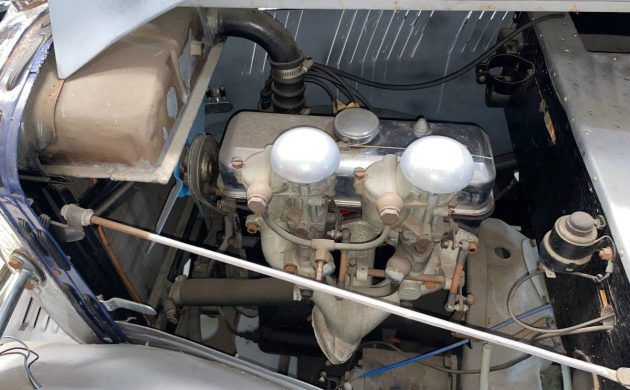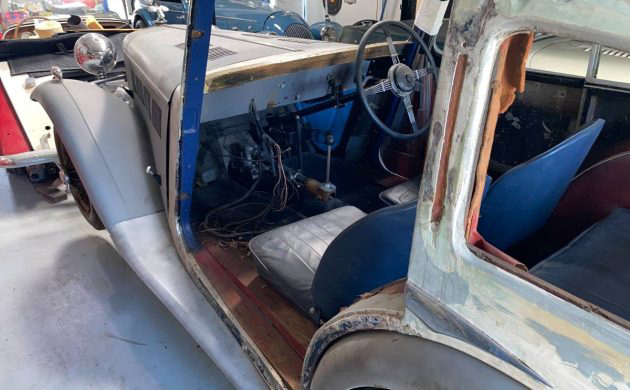I wish I had a nickel for every British car maker that began by making bicycles – ok, maybe that pile of nickels is only worth a cup of coffee these days. George Singer left Coventry Sewing Machine Company to start his bicycle company in 1874. In 1901, he slapped a motor onto a bicycle and in 1902, he made his first automobile. The Singer Nine arrived in 1933, and it was the company’s first real hit. Yes, Singers had racked up the odd racing success here and there in the interim, but the Nine put the company on the map. Its single overhead cam engine made over 26 hp. Soon, the Nine Sports followed, with a top speed of 65 mph and a very reasonable price. Today’s example is a very rare Nine Le Mans coupe, with a graceful tail and a sliding sun roof. Barn Finder numskal found this 1937 Singer for sale here on craigslist at $16,900, located in Los Angeles, California. Thanks, numskal!
Fortunately the coachwork is mostly aluminum over wood, leading to a curb weight of around 1800 lbs (an estimate based on the roadster’s roughly 1550 lbs), because this tiny engine displaces only 972 ccs, working on two main bearings. Twin Solex carbs, a larger oil pan, 7.4:1 compression ratio and a high-lift camshaft round out the Le Mans package; output is about 38 hp, though this engine doesn’t run. The gearchange is a four-speed remote-shift manual; hydraulic brakes all around were an advanced feature for the time. A video of the owner discussing the car is here.
The interior is rudimentary – the gearbox is immediately in front of the passenger’s right foot! The handsome four-spoke steering wheel is in pretty good shape! The back seat is sized for your poodle. The doors are hinged at the rear; note the trafficators are missing (from both sides). The underside is clean, indicating reasonably good treatment over the decades – or a long-ago restoration.
The seller notes that the wood framing under the bodywork needs renewal – a job that makes me feel faint just to think about it. On the other hand, despite some fading, the chrome-work is decent and most of the parts appear to be present. Most Nine Le Mans production was in roadster form, but early advertisements show that a coupe body style was offered. Neither the North American Singer Club nor the UK Singer Motor Club has photos of a coupe. No doubt this beautiful example is rare, but its value is exceptionally uncertain. Pre-war British cars have been sliding in value for several years, though its rarity might give this one a boost. What would you pay for the privilege of caretaking this unique coupe?








That’s a nice looking car. Not “frumpy” like most of the British cars of the era. Unique to say the least.
This is a unique little machine, that needs a dedicated new owner who is not interested in the monetary payoff. With the traficators missing and the small indicator lights on the front fenders someone has worked on it.
What a neat little street rod this could be!
Nobody in their right mind would want to turn such a rare car into a street rod.
No one has ever accused me of being in my right mind!
Oy vey.
That’s exactly what I saw when I looked at it for the first time . Way cool hot rod
a friend of mine restores singer le-mans and take it from me that wood work is an art and not cheap to restore,i sent photos of this car and he said prepare to spend at least 20-25000 gbp to restore to a very good standard not concours and he says at present they have no interest of spending this sort of money,they have lost 35-40% of their values from the dizzy heights of the early 2000s and the last classic car boom,the people who want this car are now very old and are few and far betwen.i would say museum only on this one.
Sad but true ….. the guy across the street where I lived in Newcastle NSW Australia about 50 years ago had one which he was slowly restoring …. he was a tinkerer and what happened to it who knows but it was a great little car – it struck me as skinny … !!
Last time I looked my left foot would be next to the gearbox, not the right one!!
This is a right hooker after all, or didn’t the writer notice that? If I had the space and fewer cars stuffed in the barn, I’d be seriously interested in this piece of history if the price dropped substantially. And considering the mostly squarish build of it, replacing wood structural members shouldn’t involve furniture-carving skills, and wood can be shaped easier than sheetmetal in some cases. The aluminum skins look to be in pretty good shape. I’m a bit surprised that the owner hasn’t tried to get the engine running – it looks very clean and if the oil has been changed properly and the engine handcranked to see how all the moving parts respond and they seem ok, it should run. With the right approach, an engine which has sat unused for many years can often be started safely so it can be evaluated further.
we started that way as well:
https://www.youtube.com/watch?v=_qI7JPdS0CU&list=PLsTkXj1KIHjcY6Rjy03T14MhL185wJ5s5&index=13&t=255s
Skip to 2 min – (5:40) – 10.
Some also came from coach building (stage coach) carriages (body by Fisher)
as they say…” It Runs like A SEWING MACHINE”!
The writer has it right Ken W Nelson re the right foot location.
Michelle refers to the passengers right foot of a passenger sitting on the left of the driver. Cheers